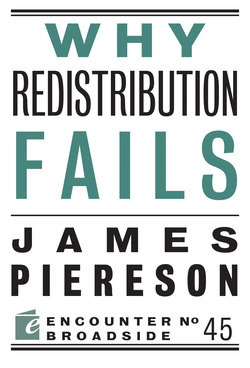Why Redistribution Fails

Реклама. ООО «ЛитРес», ИНН: 7719571260.
Оглавление
James Piereson. Why Redistribution Fails
Table of Contents
Отрывок из книги
ENCOUNTER BROADSIDES Inaugurated in the fall of 2009, Encounter Broadsides are a series of timely pamphlets and e-books from Encounter Books. Uniting an 18th century sense of public urgency and rhetorical wit (think The Federalist Papers, Common Sense) with 21st century technology and channels of distribution, Encounter Broadsides offer indispensable ammunition for intelligent debate on the critical issues of our time. Written with passion by some of our most authoritative authors, Encounter Broadsides make the case for ordered liberty and the institutions of democratic capitalism at a time when they are under siege from the resurgence of collectivist sentiment. Read them in a sitting and come away knowing the best we can hope for and the worst we must fear.
Beginning
.....
The chart illustrates two broad points. First, the wealthiest groups gradually increased their share of national income (both in pre- and after-tax and transfer income) over this 30-plus-year period; and second, federal tax and spending policies had little effect on the overall distribution of income.
Across this period, the top 1 percent of the income distribution nearly doubled their share of (pretax) national income, from about 9 percent in 1979 to more than 18 percent in 2007 and 2008, before it fell back after the financial crisis, to 15 percent in 2010 and 2011. (Some studies suggest that by 2014, it was back up to 18 percent.) Meanwhile, the top 10 percent of the income distribution increased their share by a third, from about 30 percent in 1979 to 40 percent in 2007 and 2008, before it fell to 37 percent in 2011. This was a secular trend in the distribution of national income that persisted throughout different presidential administrations and tax regimes. The path was smoothly upward for both income groups across the period, with temporary peaks and troughs corresponding with business-cycle rallies and recessions. Economists have offered different theories to explain the trend, though most agree that the causes lie in several overlapping factors, including globalization, technological change, record stock-market gains, and increasing premiums paid to highly educated workers.
.....